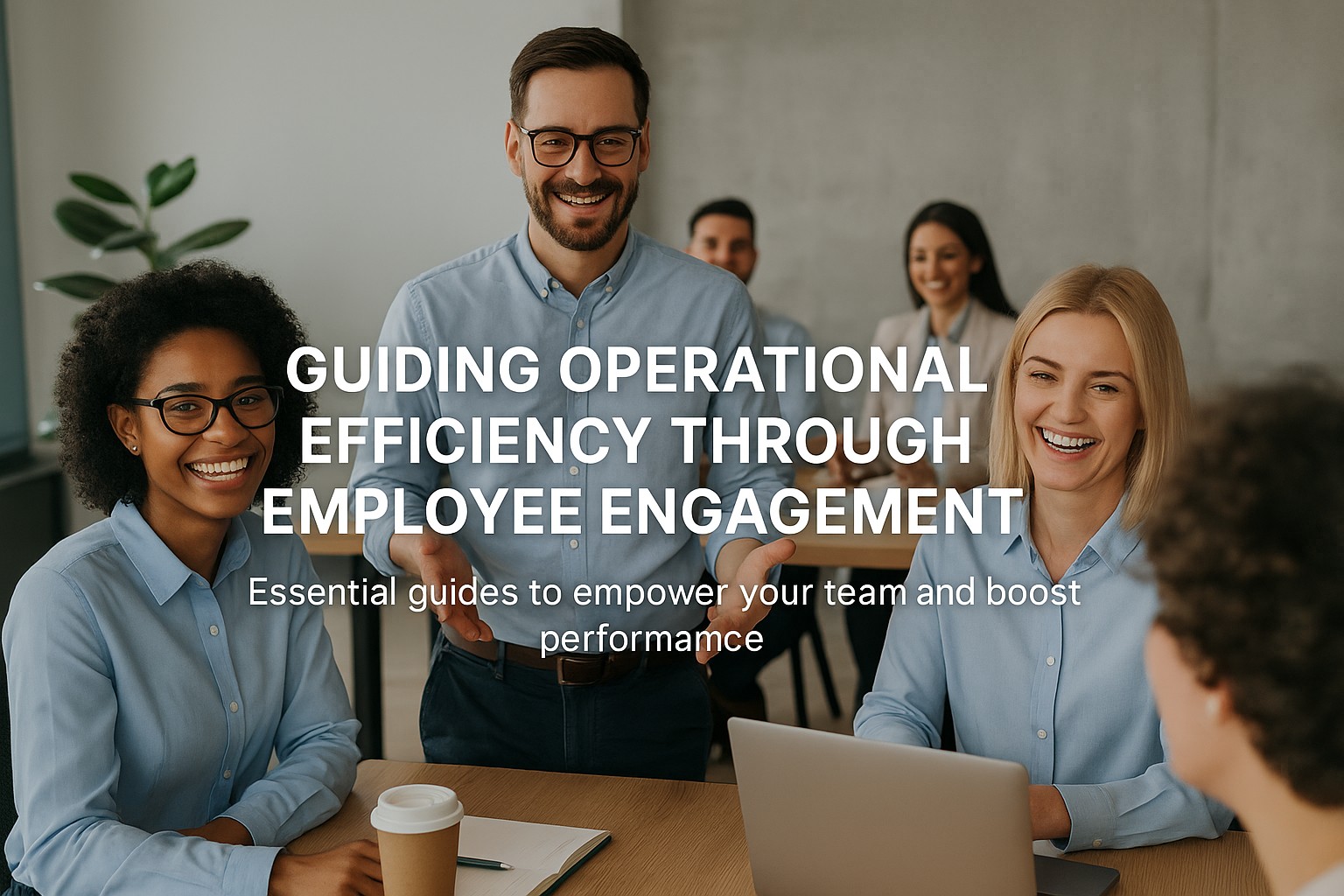
Unlocking operational efficiency is more than just a strategic goal – it's a transformative journey that hinges on one crucial element: employee engagement. Imagine a workplace where every individual is not just a cog in the machine but a driving force behind operational excellence. In this blog post, we will explore essential guides for achieving operational efficiency through employee engagement, illuminating the path for organizations to thrive in today's competitive landscape. Let's delve into the strategies that can empower your team, elevate performance, and propel your business towards success.
In order to guide employees towards operational efficiency, it is crucial to establish clear expectations and goals. This clarity provides a roadmap for employees to understand what is expected of them and how their performance contributes to the overall success of the organization.
Clearly outline performance goals and KPIs for each employee.
Align individual goals with organizational objectives to foster a sense of purpose and alignment.
Regular feedback not only helps employees understand where they stand in terms of performance but also serves as a motivator for improvement. Recognition of achievements further reinforces positive behaviors and encourages continued engagement.
Conduct regular performance reviews to provide constructive feedback.
Recognize and reward employees for their contributions to operational efficiency.
Every employee is unique and possesses different strengths and areas for improvement. By creating personalized development plans, organizations can cater to individual needs and support employees in reaching their full potential.
Identify areas for growth and development for each employee.
Offer training, mentorship, and resources tailored to individual learning preferences and career aspirations.
By implementing effective performance management systems that focus on setting clear expectations, providing feedback and recognition, and offering personalized development opportunities, organizations can guide their employees towards achieving operational excellence through enhanced engagement and performance. Regarding performance feedback, check out this case study on how a leading company optimized their feedback processes for improved operational efficiency.
Establishing mechanisms for employees to provide feedback and share suggestions is vital for fostering a culture of continuous improvement. By encouraging open communication, organizations can tap into the valuable insights and ideas that employees have to offer.
Implement regular feedback sessions or surveys to gather input.
Create suggestion boxes or digital platforms for anonymous feedback submission.
A growth mindset is essential for fostering innovation and adaptability within an organization. By encouraging employees to embrace challenges, learn from failures, and continually develop their skills, companies can create a culture that thrives on growth and improvement.
Provide training on the concept of a growth mindset and its benefits.
Recognize and celebrate employees who demonstrate a willingness to learn and grow.
Acknowledging and rewarding innovative ideas from employees not only encourages creativity but also reinforces a culture that values continuous improvement. Recognition can come in various forms, such as financial incentives, public acknowledgment, or opportunities for advancement.
Establish innovation challenges or competitions to spark creativity.
Showcase success stories of employees who have made significant contributions through their innovative ideas.
By creating channels for feedback, promoting a growth mindset, and recognizing innovative ideas, organizations can nurture a culture of continuous improvement that fuels operational efficiency through employee engagement. For inspiration on fostering innovation, explore how a renowned company like Apple is known for its innovative culture and employee engagement practices.
Transparent communication is the foundation of a cohesive and engaged workforce. By fostering an environment where information flows freely and openly, organizations can build trust and enhance collaboration among employees.
Share company updates, goals, and challenges through regular communication channels.
Encourage two-way communication by offering avenues for feedback and questions.
Open dialogue cultivates a culture of inclusivity and mutual respect within the organization. By facilitating discussions and knowledge sharing, employees feel empowered to voice their opinions and contribute to decision-making processes.
Organize regular team meetings and brainstorming sessions to encourage open discussions.
Create digital platforms or forums for employees to share insights, best practices, and resources.
In today's digital age, leveraging technology can streamline communication processes and improve efficiency. From collaboration tools to virtual meeting platforms, technology solutions play a critical role in connecting dispersed teams and facilitating seamless communication.
Implement project management tools for task assignments and progress tracking.
Utilize instant messaging platforms for real-time communication and quick decision-making.
By establishing transparent communication practices, encouraging open dialogue, and leveraging technology for efficient communication, organizations can enhance employee engagement and ultimately drive operational efficiency. To see how leading companies excel in communication strategies, explore Microsoft's approach to fostering effective internal communication among its global workforce.
To enhance operational efficiency through employee engagement, it's essential to identify existing skill gaps and training requirements within the workforce. By conducting thorough assessments, organizations can tailor training programs to address specific areas for improvement.
Perform skill gap analyses through employee performance evaluations.
Survey employees to gather insights on their training needs and career aspirations.
Continuous learning is key to fostering employee engagement and adapting to evolving business requirements. Providing opportunities for upskilling and reskilling not only benefits individual employees but also contributes to the overall competence and agility of the organization.
Implement training sessions, workshops, or online courses to develop new skills.
Encourage cross-functional learning and knowledge sharing among teams.
Access to learning resources and mentorship can significantly impact employee growth and engagement. By offering a range of learning materials and pairing employees with mentors, organizations demonstrate their commitment to nurturing talent and supporting career development.
Create a library of e-learning resources and tools for self-paced learning.
Establish mentorship programs where experienced employees can guide and support their peers.
Investing in training and development programs that focus on identifying skill gaps, offering upskilling opportunities, and providing mentorship can empower employees to reach their full potential and contribute to operational efficiency. For insights on successful training initiatives, explore Google's innovative approach to employee development and continuous learning.
Teamwork and collaboration are fundamental aspects of operational efficiency and employee engagement. By fostering a culture where teams work together towards common goals, organizations can harness the collective skills and diverse perspectives of their workforce.
Assign collaborative projects that require diverse skills and expertise.
Organize team-building activities to strengthen relationships and trust among team members.
Knowledge sharing is a powerful tool for continuous improvement and employee development. Encouraging employees to share their expertise, best practices, and lessons learned can enhance overall team performance and foster a culture of continuous learning.
Establish knowledge-sharing platforms or communities where employees can exchange ideas.
Encourage peer-to-peer training sessions where employees teach each other new skills.
Team-building activities play a crucial role in building strong relationships, enhancing communication, and boosting employee morale. By organizing events that promote teamwork and foster a sense of camaraderie, organizations can create a positive and collaborative work environment.
Plan off-site team-building retreats or social outings to strengthen team bonds.
Incorporate team challenges or games that require cooperation and problem-solving skills.
By encouraging teamwork, facilitating knowledge sharing, and organizing team-building activities, organizations can cultivate a collaborative and communicative work culture that drives operational efficiency through enhanced employee engagement. Explore how companies like Amazon prioritize team collaboration and communication to achieve business success.
Key Performance Indicators (KPIs) serve as essential metrics for measuring employee engagement and operational performance. By defining and monitoring relevant KPIs, organizations can assess the effectiveness of their strategies and make data-driven decisions to drive continuous improvement.
Identify specific KPIs related to employee engagement, such as satisfaction levels and retention rates.
Track operational KPIs, including productivity metrics and process efficiency indicators.
Employee feedback is a valuable source of insights for evaluating engagement levels and identifying areas for improvement. Regular surveys and feedback sessions provide employees with an opportunity to voice their opinions, concerns, and suggestions, ultimately contributing to a more engaged and motivated workforce.
Design surveys to gather feedback on employee satisfaction, communication effectiveness, and support systems.
Conduct focus groups or one-on-one feedback sessions to delve deeper into employee perceptions and experiences.
Data-driven decision-making is crucial for optimizing operational efficiency and maximizing employee engagement. By analyzing the gathered data, organizations can identify trends, patterns, and areas of inefficiency, leading to targeted interventions and process enhancements.
Utilize analytics tools to interpret KPI data and employee feedback effectively.
Implement changes based on data insights to address performance gaps and enhance engagement levels.
By utilizing key performance indicators, conducting employee surveys, and making data-driven decisions, organizations can continuously monitor and improve both employee engagement and operational efficiency. To see how a leading company like IBM leverages data for performance optimization and employee engagement, explore their innovative data analytics strategies.
To ensure lasting impact and continuous improvement in operational efficiency, organizations must develop a comprehensive and long-term employee engagement strategy. This strategy should encompass various initiatives and programs aimed at fostering a culture of engagement and accountability.
Define overarching goals and objectives for employee engagement.
Regularly review and update the engagement strategy to adapt to changing organizational needs.
The workforce is constantly evolving, and organizations must be agile in responding to changing employee demographics, preferences, and expectations. By staying attuned to workforce dynamics and needs, companies can tailor their engagement initiatives to resonate with employees across different generations and backgrounds.
Conduct regular assessments of employee demographics, preferences, and engagement levels.
Implement flexible engagement programs that cater to diverse workforce needs and preferences.
Effective employee engagement is an ongoing process that requires constant evaluation and optimization. By regularly measuring the outcomes of engagement initiatives, organizations can identify areas of success and improvement, leading to enhanced employee satisfaction and operational efficiency.
Collect feedback from employees on the effectiveness of engagement programs.
Use performance data and engagement metrics to refine and enhance engagement strategies over time.
By creating a sustainable engagement strategy, adapting to workforce dynamics, and continuously evaluating engagement programs, organizations can foster a culture of engagement that drives operational efficiency and employee satisfaction. Discover how industry leaders like Cisco sustain their employee engagement efforts and achieve organizational success through long-term strategies and continuous optimization.
In today's dynamic business landscape, achieving operational efficiency requires more than just streamlined processes and advanced technology. Employee engagement plays a pivotal role in driving organizational success by empowering employees to contribute their best efforts and ideas towards shared goals.
By implementing the guides discussed in this post for achieving operational efficiency through employee engagement, organizations can create a workplace culture where employees are motivated, empowered, and committed to driving innovation and excellence. Through transparent communication, continuous learning opportunities, and a focus on collaboration and feedback, companies can unlock the full potential of their workforce.
Sustaining employee engagement initiatives and adapting to evolving workforce needs are essential components of long-term success. By investing in training and development, fostering teamwork and collaboration, and using data-driven insights to optimize performance, organizations can position themselves for sustainable growth and operational excellence.
As businesses navigate the complexities of today's market environment, prioritizing employee engagement is not just a choice but a strategic imperative. By following the comprehensive guides outlined in this post and leveraging industry best practices from leading organizations like Salesforce, your company can embark on a journey towards operational excellence, enhanced employee engagement, and long-term success.
Take the first step today and unlock the potential of your workforce to drive operational efficiency and transformation. Together, we can create a workplace where purposeful organizations thrive, teams excel, and success becomes a collective reality.
Employee engagement is a catalyst for operational efficiency as it motivates employees to perform at their best, contribute innovative ideas, and collaborate effectively with colleagues. Engaged employees are more committed to the organization's goals, leading to increased productivity and improved overall performance.
Effective communication, recognition of achievements, opportunities for growth and development, and promoting a culture of inclusivity and teamwork are vital strategies for fostering employee engagement. By implementing these initiatives, organizations can create an environment where employees feel valued, motivated, and invested in their work.
Organizations can measure employee engagement through surveys, feedback sessions, and analyzing key performance indicators related to employee satisfaction, retention rates, and productivity levels. Regular assessments allow companies to gauge the effectiveness of their engagement initiatives and make data-driven decisions to enhance employee engagement.
Continuous learning promotes employee growth, skill development, and adaptability, which are essential for both employee engagement and operational efficiency. By providing opportunities for employees to upskill and reskill, organizations empower their workforce to stay competitive, drive innovation, and contribute to overall organizational success.
To ensure the sustainability of employee engagement initiatives, companies should develop a long-term engagement strategy, adapt to changing workforce dynamics, regularly evaluate the effectiveness of engagement programs, and use data-driven insights to optimize performance. By continuously refining their engagement strategies, organizations can create a culture of engagement that drives sustained operational efficiency and success.


Lessons from 2025. The real blockers were not strategy or tech. They were decisions, load, trust, and habits. Practical moves for 2026.


Learn how to turn your company’s values into daily actions with simple micro-habits !

.png)
New research shows your middle managers decide if change sticks. See how to support them with simple weekly habits and real practice labs.
